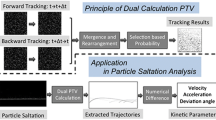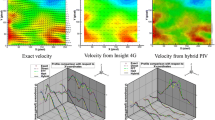Abstract
A new particle tracking velocimetry (PTV) algorithm, which has no interpolation process requirement, has been constructed. An affine transformation and a hybrid fitness function were used to obtain final vector fields. A match probability method (MPM)-based PTV algorithm was used to save calculation convergences. The constructed algorithm was tested with synthetic images using the numerical data of Taylor-Green vortex flow and experimental images for the flow of a rectangular body with Re = 5300. Results obtained by the constructed PTV algorithm were compared with those obtained by the conventional cross-correlation particle image velocimetry (PIV) and the MPM. Comparison results revealed that the constructed interpolation-free PTV (IFPTV) algorithm demonstrated better performance than the aforementioned PIV and PTV algorithms. Furthermore, the constructed PTV algorithm does not need an error removal and interpolation process, enabling easy processing in PTV calculations while providing high-resolution grid vectors.
Similar content being viewed by others
Abbreviations
- A, B :
-
Constants for convergence speed
- a :
-
Coefficient of affine transformation
- c :
-
Degree-of-correspondence
- D :
-
Relative distance of quasi-rigid condition
- d :
-
Distance between two particles
- f :
-
Particle on the 1st PTV image
- I :
-
Intensity of synthetic image
- I 0 :
-
Maximum intensity of synthetic image
- L :
-
Size of Tylor-Green vortex
- M :
-
Amplitude of Taylor-Green vortex
- N :
-
Number of candidate vector of PTV method
- P :
-
Probability of MPM method
- Q:
-
Adjustment probability of MPM method
- s :
-
Particle on the 2nd PTV image
- T m :
-
Constant for maximum movement of particles
- T n :
-
Constant for neighbor particles
- T q :
-
Constant for quasi-rigid condition
- t :
-
Iteration of PTV algorithm
- w :
-
Vorticity
References
R. J. Adrian, Particle-imaging techniques for experimental fluid mechanics, Fluid Mech., 23 (1991) 261–304.
H. T. Huang, H. E. Fiedler and J. J. Wang, Limitation and improvement of PIV, part I: limitation of conventional techniques due to deformation of particle image patterns, Exp. Fluids, 15 (1993) 168–174.
F. Scarano, Iterative image deformation methods in PIV, Meas. Sci. Technol., 13 (2002) R1–R19.
D. Di Florio, F. Di Felice and G. P. Romano, Windowing, reshaping and re-orientation interrogation windows in particle image velocimetry for the investigation of shear flows, Meas. Sci. Technol., 13 (2002) 953–962.
B. Lecordier and M. Trinité, Advanced PIV algorithms with image distortion validation and comparison using synthetic images of turbulent flow, Particle Image Velocimetry: Recent Improvements, Springer, Berlin, Heidelberg (2004).
T. Astarita and G. Cardone, Analysis of interpolation schemes for image deformation methods in PIV, Exp Fluids, 38 (2005) 233–243.
P. Westfeld, H. G. Maas, O. Pust, J. Kitzhofer and C. Brücker, 3-D least squares matching for volumetric velocimetry data processing, 15th Int. Symp. on Applications of Laser Techniques to Fluid Mechanics, Lisbon, Portugal (2010).
F. Scarano and M. Riethmuller, Advances in iterative multi-grid PIV image processing, Exp. Fluids Suppl., 29 (2000) S51–S60.
T. Utami, R. F. Blackwelder and T. Ueno, A cross-correlation technique for velocity field extraction from particulate visualization, Exp. in Fluids, 10(4) (1991) 213–223.
M. Marrazzo, F. De Gregorio and G. P. Romano, The use of a deformable weight function and of advanced validation procedures in PIV, 12th International Symposium on Applications of Laser Techniques to Fluid Mechanics, Lisbon (2004).
S. J. Baek and S. J. Lee, A new two frame particle tracking algorithm using match probability, Exp. In Fluids, 22 (1996) 23–32.
K. Ohmi and Y. L. Hang, Particle tracking velocity with new algorithms, Meas. Sci. Technol., 11 (2000) 603–616.
M. Ishikawa, Y. Murai, A. Wada, M. Iguchi, K. Okamoto and F. Yamamoto, A novel algorithm for particle tracking velocimetry using the velocity gradient tensor, Exp. Fluids, 29 (2000) 519–531.
D. H. Doh, D. H. Kim, K. R. Cho, Y. B. Cho, T. Saga and S. K. Kobayashi, Development of genetic algorithm based 3D-PTV technique, Journal of Visualization, 5 (2002) 243–254.
M. Miozzi, Direct measurement of velocity gradients in digital images and vorticity evaluation, 6th International Symposium on Particle Image Velocimetry, Pasadena (2005).
X. Song, F. Yamamoto, M. Iguchi and Y. Murai, A new tracking algorithm of PIV and removal of spurious vectors using Delaunay tessellation, Exp. Fluids, 26 (1999) 371–380.
R. K. Cohn and M. M. Koochesfahani, The accuracy of remapping irregularly spaced velocity data on to a regular grid and the computation of vorticity, Exp. Fluids, 29 (2000) 519–531.
C. E. Willert and M. Gharib, Digital particle image velocimetry, Exp. Fluids, 10 (1991) 181–193.
J. Nogueira, A. Lecuona and P. A. Rodriguez, Data validation, false vectors correction and derived magnitudes calculation on PIV data, Meas. Sci. Technol., 8 (1997) 1493–1501.
Acknowledgments
This work was supported by the BK21 Four program through the National Research Foundation of Korea (NRF) funded by the Ministry of Education of Korea (Center for Creative Leaders in Maritime Convergence) and supported by Basic Science Research Program through the National Research Foundation of Korea (NRF) funded by the Korea Government (Nos. 2018R1A2B6009387 and 2021R1I1A01054535).
Author information
Authors and Affiliations
Corresponding author
Additional information
Min-Gyu Jeon earned his B.S. and M.S. degrees in Refrigeration and Air-conditioning Eng. at Korea Maritime & Ocean Univ. (KMOU) in 2012 and 2014, respectively. He received his Ph.D. degree in the Dept. of Mech. Eng. in Tokushima Univ., Japan, in 2018. He is currently a Research Professor in the Div. of Mech. Eng. at KMOU. His research interest includes the areas of fundamentals of combustion and flow visualizations in industry and marine and offshore machinery.
Deog-Hee Doh earned his B.S. and M.S. degrees in the Dept. of Marine Eng. at Korea Maritime & Ocean Univ. (KMOU) in 1985 and 1988, respectively. He received his Ph.D. degree in the Dept. of Mech. Eng. in Tokyo Univ., Japan, in 1995. He is currently the President at KMOU. His main interests include the areas of flow visualizations in industry and marine and offshore machinery.
Gyeong-Rae Cho earned his B.S. and M.S. degrees in Refrigeration and Air-conditioning Eng. at Korea Maritime & Ocean Univ. (KMOU) in 1999 and 2001, respectively, and his Ph.D. degree in the Dept. of Product Sciences in Saitama Univ., Japan, in 2004. He is a Research Professor at Korea Maritime & Ocean Univ. His main interests are computational fluid dynamics, flow visualization, and artificial intelligence in industry.
Rights and permissions
About this article
Cite this article
Jeon, MG., Doh, DH. & Cho, GR. Development of interpolation-free PTV. J Mech Sci Technol 35, 4023–4032 (2021). https://doi.org/10.1007/s12206-021-0815-6
Received:
Revised:
Accepted:
Published:
Issue Date:
DOI: https://doi.org/10.1007/s12206-021-0815-6




